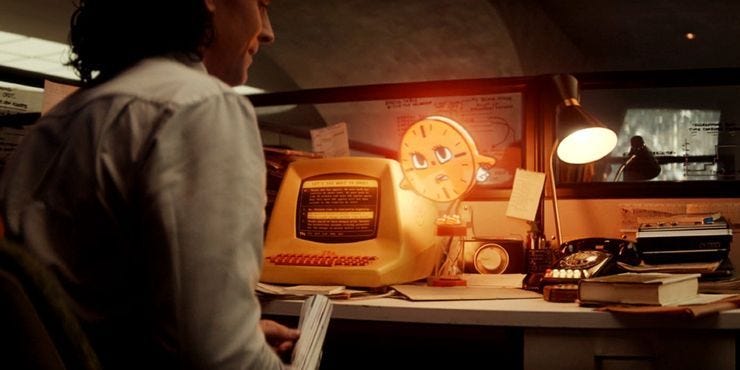Opening a can of tasty, tasty worms
Loki S1E1 established the peak MCU benchmark. And this week in mythology, Calypso, the nymph who detained Odysseus for seven years. Was she actually a goddess of death?
Over 3,000 subscribers? Wow! I am so grateful for your support.
If you’re looking for Wordlers, or for storytelling NFTs, there’s news on the way. If you’re here for interesting mythology tidbits, I have a good one. But first, you’ll have to endure another of my belated hot takes on the Marvel Cinematic Universe. This one at least is on topic because it’s about Loki.
Item One: Loki S1E1 is Peak MCU
In my hot takes on Avengers: Endgame (2019), I was critical of the can of worms opened by introducing time travel into the MCU, enabling time-loops, paradoxes, and alternate timelines that could overwhelm the narrative of future media while potentially altering or erasing the events of prior films.
For example, during Endgame, the Avengers assembled themselves into scenes from Avengers (2012), Marty McFly style. A flub of heroic proportions then dropped the Blue McGuffin Tesseract into Loki’s hands and enabled his escape from custody. The future Avengers not only failed at their attempted stone extraction, they also created a timeline in which their past-Avenger counterparts failed two of their primary objectives (1. Capture Loki, and 2. Secure the Tesseract). We can also imagine that they swapped their shwarma-fueled victory celebration with a vigil at Tony Stark’s bedside in the nearest cardiac unit.
When the future Avengers returned to their own timeline, they encountered no repercussions. The botched timeline branch was just never mentioned again. But when Captain America went back to fix all the other branches they’d created, this version of the Space Stone couldn’t have been reset to its proper place, leaving a dangling plot thread that became the six-episode made-for-streaming first season of Loki.
If Endgame opened a can of time-travel worms, Loki was what crawled out of it next. As presented in Loki, the superfluous timeline problems of 2012 New York fell into the purview of the Time Variance Authority, the greatest power in the MCU that we’d never needed to know about before. In Loki Season 1, Episode 1, the extra timeline is pruned and the rogue Loki from Endgame is put on trial for his “crimes” against the Sacred Timeline.
Why aren’t the Avengers held responsible for opening the can of time-travel worms? “Because what they did was supposed to happen,” says the Time Judge. As Loki always suspected, the universe really is rigged against him.
Everything about the pilot episode of Loki was perfectly planned and executed. Owen Wilson has never had a more suitable role. Tom Hiddleston has never given a better performance. The dialogue was full of snappy quips and callbacks. The plot was among the most compelling heel-to-face setups ever seen. The episode took risks. It used the MCU continuity to great effect. It addressed and fixed a plothole that had dragged down a prior movie. Every background character was positioned like a piece on a chessboard, every prop told a story, and every detail of the set design enhanced the worldbuilding.
Can I mention the light fixtures?
Instead of having a few bright lights, the TVA headquarters packs its ceilings with fixtures that each hold a single dim incandescent bulb. This upward shot shows us, in seconds, everything we need to know about the culture and aesthetic of a bureaucracy with limitless resources and no environmental concerns.
Can I mention the screens?
The TVA, with access to unlimited technology, still uses rotary phones, typewriters, card catalogs, paper files, and tiny amber-tinted monochrome CRT monitors. This is the aesthetic of an organization with no incentive to advance anything beyond its most basic level of utility.
The TVA’s handheld devices are similarly low-res, though incongruously linked to an interactive AI with an advanced holographic interface and 1950s PSA character design. Most humorous of all, even with the ability to call up doors to anywhere in time and space, the TVA uses office tower elevators within its own headquarters!
Can I mention the paper tickets?
To get onto the court docket, a prisoner needs to take a paper ticket, deli-counter style, and proceed through a serpentine line of roped stanchions to a service counter. At some time in the past, this system must have been necessary to manage heavy traffic. But even though there’s no longer a line to manage, the penalty for misplacing the absolutely unnecessary ticket is death. The organization has no compassion and no incentive to update its protocols to account for changed conditions.
The superficial villain of the episode is a “variant” who’s been killing TVA hunters, but the real villain is the TVA’s systemic bias against all life forms from branches outside the so-called Sacred Timeline. The crime prosecuted by their kangaroo court is any expression of free will outside the scope ordained by the all-knowing and never-questioned Time Keepers, a literal conspiracy of space lizards. The staff of the TVA are presented as semi-competent and well-intentioned, and Owen Wilson as Morbius brims with compassion, but the organization itself is a fascist state that’s clamped down on the entire universe.
This makes the TVA, or the powers behind it, a substantially more formidable enemy than some big purple dude with a gauntlet of magic stones. Thanos may have temporarily wiped out half a universe, but the TVA routinely prunes entire timelines. The rise and fall of Thanos is a blip within the TVA’s sphere of control, with the Snap being just another part of the Time Keepers’ master plan.
Also, the TVA desk jockeys use Infinity Stones as paperweights, having a surplus supply and no other purpose for them. What a perfect metaphor for the TVA’s wasted power and the oblivious, uncurious attitude of its workers!
Loki S1E1 was peak MCU. It paid off the 22 movies that came before it and set a benchmark that, unfortunately, couldn’t be matched by the rest of the season. As a bonus, it showcased Loki, the shapeshifting trickster pulled from the lore of Norse mythology.
The best part— One of the best parts— One among a countless number of best parts was the TVA staffers’ insistence on referring to Loki as “Mr. Laufeyson.”
Loki is Odin’s and Frigga’s adopted son, a frost giant by birth, and much of the internal conflict in his MCU incarnation has come from his status as an Asgardian prince being at odds with his outsider origins. Loki, aspiring to the throne of Asgard, always refers to himself as “Loki Odinson,” using his adopted patronym even as he struggles to deserve it.
The Gylfaginning and Skáldskaparmál, primary sources of Norse mythology, both refer to Loki with the matronym, “Laufeyjarson,” at least part of the time. Laufey is the name of Loki’s birth mother in the mythology or, confusingly, of his biological father in the MCU adaptation. Either way, for the MCU’s Loki, “Laufeyson” is a technically accurate but hurtful reminder of the social status at the root of all his insecurities.
The TVA insist on using this name because this aspect of Loki’s nature is the one that the Time Keepers want to emphasize. In the Sacred Timeline, Loki is only ever meant to be a villain. Events that may have led him to more heroic outcomes have all, so far, been pruned away.
Watching Endgame was like eating in a restaurant where the chef has opened a can of worms, to mixed effect, because there’s no other way to finish his ambitious Stew of Crossover Ingredients.
Watching the first episode of Loki was like having another chef step in and use those same leftover worms to whip up a frittata, and having that frittata be the most unexpectedly delicious thing you’ve ever tasted.
Loki S1E1 was so good, it made me forget that I was eating worms.
Item Two: Is Calypso a Greek goddess of death?
In Greek mythology, Calypso was a nymph encountered by Odysseus during his ten-year journey home from the Trojan War. According to Homer, a dalliance with Calypso was responsible for seven years of his delay.
In Homer’s Odyssey, Calypso is a daughter of Atlas who lives on and embodies the island of Ogygia. In Hesiod, Calypso is the daughter of Oceanus and Tethys and, as an Oceanid, is more accurately associated with the sea surrounding her island home. According to Apollodorus, Calypso is the daughter of Nereus and Doris, making her one of the Nereids under the control of Poseidon, Odysseus’s mortal enemy.
But what if all these disagreeing sources are covering up an older truth? What if Calypso were originally a goddess of death?
I came across a passing reference this week to a theory that Calypso is cognate to Kolyo the Coverer, a reconstructed goddess from the Proto-Indo-European pantheon who represented the grave. Textual evidence may even place Calypso on the Trojan battlefield during Homer’s Iliad, where she would have dragged dead and dying warriors directly into the afterlife. If so, this likely would have been where she’d first spotted Odysseus and marked him as a future conquest.
In the Odyssey, Calypso offers Odysseus an opportunity to spend eternity with her, which is commonly interpreted as an offer to make him immortal. But in an earlier form of the story, where Calypso was still a goddess of death, perhaps what she offered was a favored position in the afterlife.
As a reminder, Homer’s Iliad and Odyssey, the stories we have, represent only one version among a countless number of story variants with deep roots in older sources. Thousands of years before the MCU, a Homeric Multiverse was already circulating across Europe and Central Asia.
Incidentally, Kolyo the Coverer has a Hindu cognate in the goddess Kali and a Norse cognate in Hel, a goddess of death and of an underworld realm that bears her name. In the MCU adaptation, Hel became Hela, a sister to Thor and Loki who played a central role in Thor: Ragnarok.
Hela’s horns evoke worms of the grave or ropes of a hangman’s noose, both of which were symbols associated with Hel, and also with Kolyo, who would bind the dead in unbreakable ropes before leading them to the afterlife.
This makes the MCU a part of the same storytelling complex that includes the mythologies of many ancient cultures. So when you’re watching Thor movies or the Loki series, keep in mind that these characters had an older sister who, in her Greek form, had a notorious affair with the trickster king, Odysseus.
That blew my mind.
Item Three: Wordlers and other storytelling NFTs
The NIGHTfall storyline of Wordlers is over and was a great success. All 23 episodes released over the course of September, introducing new characters and developing the Wordlers story world. Thousands of story tokens were claimed, and I’m leaving the last handful of episodes available to be collected for a few days longer. They are free to read always and free to collect while they last.
This month, I’m planning out the logistics of using tokens to grant co-author rights in various story elements of the Wordlers universe. This will be the template for a better form of fanfic, where the original creators can be explicit about what rights they are granting to which story elements, who holds those rights, and what exactly they can do with them. Details forthcoming.
I’m also setting up a community for the discussion and planning of Web3 publishing and storytelling NFTs. Look for news, coming soon.
—Greg R. Fishbone, Mythology Disruptor








